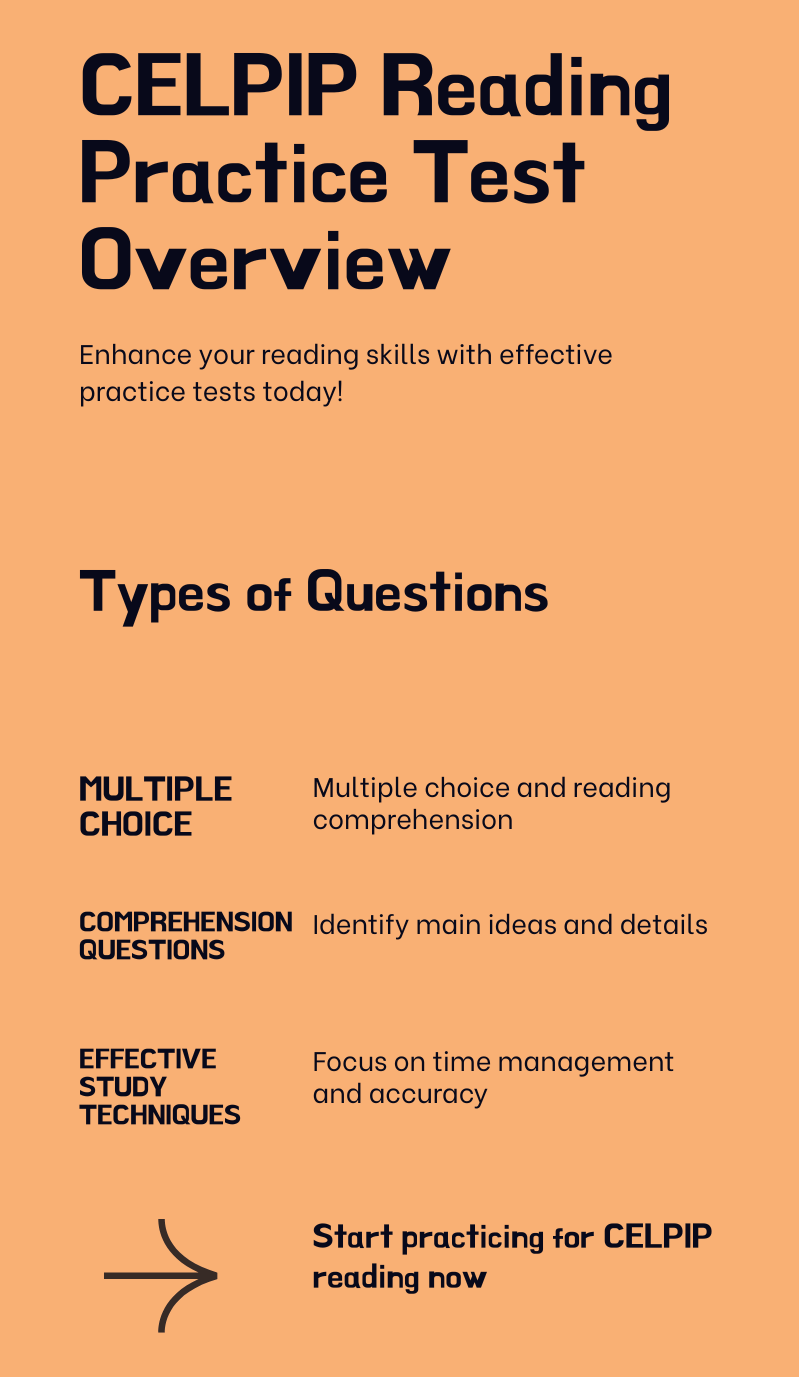The Celpip reading section evaluates how effectively you understand written English in workplace situations or even everyday situations too. Consistent practicing with CELPIP reading practice tests is one of the best ways to strengthen reading skills and perform confidently and score good in the Celpip Reading Section.
In this blog, you’ll learn the importance of practice tests, CELPIP Reading Test structure and tips to improve reading performance in the test.
Let’s Understand the CELPIP Reading Test first:
The CELPIP Test evaluates your ability to use the English language in real-life situations. The reading section calculates how efficiently you understand the written passages and explain different types of intelligence.
There are 4 parts in CELPIP Reading Test:
-
Reading Correspondence – You’ll read a short message, letter or an email and then answer the related questions.
-
Reading to Apply a Diagram – You’ll explain data from maps or charts and answer practical questions.
-
Reading for Information – This section carries long informational passages, like reports or articles.
-
Reading for Viewpoints – You’ll read texts expressing arguments or opinions and then answer questions to identify outlooks.
In this section, you’ll have around 55 to 60 minutes total to complete.
The Importance of CELPIP Reading Practice Tests
Practicing regularly with CELPIP reading practice tests helps to become aware of the test format and improves the skills required to understand complex/difficult English texts. Let’s have a look how Celpip Reading Practice Tests make a difference:
-
Familiar with Format: Practice Celpip Reading Tests helps to get familiar with the actual test experience, this will help to know what to expect.
-
Enhanced Time Management: With regular practicing you will learn how to manage your time wisely so that you can complete all of your questions within the given time limit.
-
Improved Comprehension Skills: Reading practice helps you identify supporting details, main ideas and intimated meanings more efficiently.
-
Better Grammar and Vocabulary Awareness: The more you read, the more you understand sentence structures and word meanings.
-
Upgrade Confidence: Practicing regularly and knowing the exact pattern reduces stress on test-day and helps to build confidence.
Best Strategies for CELPIP Reading Practice
To score more in the CELPIP Reading Section, you should use the right strategies. Here are some best strategies that will to improve your CELPIP Reading Section performance:
1. Practice Scanning and Skimming
-
Scanning means finding out some specific information, like names or dates.
This strategy will help to save lots of time and find out answers faster during the final test. -
Skimming means to read quickly, this helps to understand the main idea of the given passage.
2. Identify Keywords
When reading questions, note or underline keywords. This activity will help you to find the relevant part of the passage without wasting time.
3. Practice Active Reading
Ask some questions to yourself such as “What is the tone of this passage?” or “What’s the author’s purpose?”Active reading helps to improve your comprehension.
4. Enhance Your Vocabulary Skills
A wide-ranging vocabulary makes it easier to understand complex texts. Practice new words daily and use them in context.
5. Evaluate Errors
After attempting the practice test, analyze your incorrect answers very carefully.

What Topics Should You Choose for CELPIP Reading Practice
Here are examples of reading materials, you might choose during your CELPIP Reading Practice:
-
Letter or Emails: Responding to workplace updates or customer inquiries.
-
Schedules or Charts: Interpreting a meeting calendar or flight schedule.
-
Informational Articles: Reading about health topics, environment or community events.
-
Opinion-Based Texts: Understanding debates about lifestyle choices or public transportation.
Regular practicing such types of passages help to build ability, comprehension and speed.
Challenges in the CELPIP Reading Test
There are some challenges that many test-takers struggle while practising like:
-
Reading too slow, this is one of the most common challenges that a test taker generally faces which makes him run out of time.
-
Misunderstanding questions or selecting answers just based on the guesses.
-
Difficulty distinguishing between minor details and main ideas.
-
Not reviewing answers again before stepping forward to the next question.
It is very important to overcome these challenges to score well, that’s why practising regularly under timed conditions is the only key to achieve success.
Tips for Stable Improvement
Here are some tips that an applicant need to keep in mind while doing reading practice:
-
Read English articles, blogs and newspapers daily.
-
Take short reading quizzes.
-
Discuss ideas or passages with your study partner to exchange thoughts.
-
Set small achievable goals — like improving your reading speed just by a few seconds per question.
-
Monitor your progress by recording your answer and then analyzing your area of improvement.
Conclusion
Preparing for the CELPIP Reading Test needs a mixture of consistent practice, patience and strategy. By regularly practicing CELPIP reading practice tests, you’ll gain confidence in handling different types of question formats and will also improve your comprehension skills. You can practise CELPIP Reading Test on a real time based practice platform i.e CelpipStore, this platform is having more than 250 of practice tests, which will be definitely helpful to you in achieving your goal.
Celpip Reading Practice Task
| Celpip Reading Practice Task Sample 1: |
Part 1: Celpip Reading correspondence
| Celpip Reading Correspondence Task Sample 1: | Celpip Reading Correspondence Task Sample 2: |
Part 3: Celpip Reading for Information
| Celpip Reading for Information Task Sample 1: |
Part 4: Celpip Reading for ViewPoints
| Celpip Reading for ViewPoints Sample 1: | Celpip Reading for ViewPoints Sample 2: |


